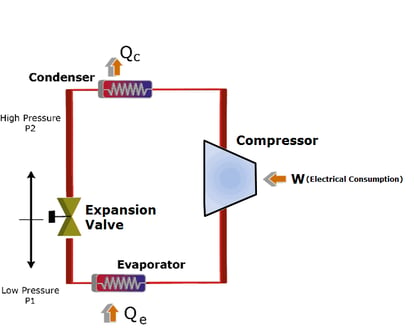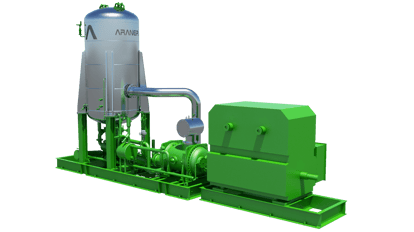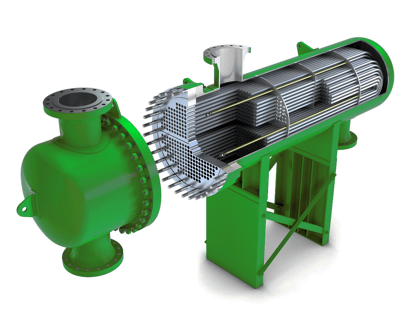The refrigeration cycle removes unwanted heat from one place and discharges that heat in another area. The process is accomplished, in short, by the pumping of refrigerant through a closed system. This system is composed of several components which enable the process to work.
In the realm of industrial processes, the intricate dance of temperature control plays a pivotal role in ensuring the efficiency, reliability and quality of operations. At the heart of this thermal ballet lies the refrigeration cycle, a remarkable engineering marvel that accomplishes the seemingly magical feat of removing unwanted heat from one location and judiciously depositing it in another.
In essence, it orchestrates the delicate balance between hot and cold, all within a closed system, making it a linchpin of modern industrial applications. This complex choreography unfolds through the rhythmic pumping of refrigerants and it is a symphony composed of several intricately designed components, each with a unique role to play.
In this comprehensive exploration, we delve deep into the inner workings of industrial process refrigeration, dissecting and scrutinizing each component's significance, function and contributions to this essential thermal performance.
Join us on this journey to unravel the inner workings of a critical industrial process – one component at a time.
 Figure 1: The Industrial Refrigeration Cycle
Figure 1: The Industrial Refrigeration Cycle
- A compressor pressurizes the refrigerant.
- A condenser, where the refrigerant condenses from vapor to its liquid form giving off heat.
- A metering device regulates the flow and consequently lowers the pressure, of the refrigerant.
- An evaporator also referred to as a cooling coil, where the refrigerant expands removing heat from the area as the refrigerant “evaporates” changing into its vapor state once again.
- It prevents the loss of the refrigerant to the atmosphere when it vaporizes
- It allows the use of the same refrigerant cycle after cycle, to remove heat and discharge it
Components of an industrial refrigeration process
Refrigerants
Refrigerants are the liquids used to transfer heat from one area to another in vapor compression refrigeration systems. These refrigerants take on different forms as they change temperature and pressure. When the temperature of the system increases the refrigerant becomes a vapor, and when the pressure of the vapor increases, it becomes hot. When the refrigerant vapor cools, it converts back to its liquid state, and when it loses pressure, it cools further. The cooled refrigerant then reenters the unit to pick up more heat and begin the cycle once again .
The refrigerant initially installed in a system will often last its lifetime without ever needing to be replaced or recharged unless something goes wrong, such as a leak in the closed system. The most common refrigerants in industrial refrigeration applications is Ammonia (R717) and R-134a, which is halogen free for safety, health, and environmental friendliness. Ammonia is also one of the oldest refrigerants and has superior heat absorption compared to other refrigerants, but it still has its own set of safety concerns. Other refrigerants are available for applications where ammonia may not be ideal; these might include Carbon Dioxide (R744), Hydrofluorocarbons (HFC), Fluorocarbons (FC), or hydrocarbons.
Check out this blog post for further explanation on refrigerants used in Industrial Refrigeration plants or follow up with ARANER for more information to help determine which refrigerant is right for your application.
Compressor
 Figure 2: Compressor
Figure 2: Compressor
Vaporized refrigerant enters a compressor, which raises the pressure of the refrigerant and increases the temperature of the vapor; this also increases the density of the vapor. The vapor temperature must be made higher than that of the condensing fluid employed in the condenser for the refrigeration cycle to be effective. The heat can only be released when the condensing vehicle, such as air or water, is somewhat cooler than the refrigerant.
In addition, the compressor acts as a pump to move the refrigerant through the closed system. Compressors used in industrial refrigeration applications may be of the screw, piston, centrifugal, or rotary type. Regardless of the type of compressor employed, they perform the same primary function, to increase the pressure of the refrigerant. The two types most often used in refrigeration applications are the centrifugal and the screw-type compressors. Centrifugal compressors commonly used in large chemical and processing applications as well as water cooling air-conditioning applications like direct cooling.
Which type of compressor do you need? ARANER can guide you through the decision-making process and help to ensure that you look at all the factors which may dictate one type of compressor over the other.
Condenser
The hot, gaseous refrigerant leaving the compressor enters the coil, known as the condenser, commonly located outdoors. The condenser coil is exposed to a cooling medium which allows the refrigerant to release heat; usually, through the exposure of the coil to the outside air, water, other fluids, or some combination thereof. The heat removed as the refrigerant travels through the condenser results in the refrigerant beginning to condense, return to its liquid state.
The condenser is a series of tubes which the refrigerant moves through, hence the term coil. The condenser is often accompanied by a fan which forces air across the surfaces and increases the heat dissipation. The refrigerant leaves the condenser at cooler a temperature, but still under the pressure provided by the compressor. There are three different types of condensers used in industrial refrigeration; these are air-cooled, water-cooled, and evaporative. Air-cooled condensers expose the heated refrigerant to outside air which absorbs heat from the hotter refrigerant, sometimes with the help of a fan or blower to blow air across the condenser surface.
A water-cooled condenser generally consists of two sets of tubing in direct contact with each other, one containing the refrigerant and the second cooling water; the refrigerant condenses on the walls of the tubing as the heat transfers to the colder water. An evaporative condenser works much like a cooling tower, where water sprays onto the coil carrying the refrigerant and heat is thus exchanged. A small amount of the water sprayed onto the coil evaporates as a result of the heat contained in the refrigerant and helps to cool the remaining water as it falls to the basin below. The heat-laden, moist air passes through a drift eliminator, to prevent substantial water droplets and mist from escaping and then the heat is forced out with a fan or blower.
More industrial refrigeration applications use evaporative condensers than air- or water-cooled condensers, though specific applications or locations may find that one is a better choice operationally than the others. ARANER can provide you with the information necessary to determine which type of condenser is best suited for your project and location.
Metering Device
Upon leaving the condenser, the refrigerant travels through a metering device, usually an expansion valve, which performs two essential functions in the refrigeration cycle. First, it slows the flow rate of the refrigerant into the evaporator to a pace at which the evaporator can “boil” the liquid refrigerant and turn it to steam or vapor.
Second, the valve provides a pressure drop for the refrigerant. That means the valve is the separation between the high pressure (hot) side of the system, between the compressor and this point, and the low pressure (cool) side of the system, from this point back to the compressor. These valves may be temperature sensing, opening as temperature increases and closing as temperature decreases, while others dynamically adjust by sensing the pressure of the refrigerant as it leaves the evaporator. The metering device, regardless of the type used, allows the refrigerant to pass through and as it does it nearly immediately becomes a lower pressure, cooled liquid.
It is worth noting that in some instances a fixed orifice valve, variable flow valve, capillary tube or some other device which controls the flow of the refrigerant may be employed as a metering device, ARANER can help you determine which metering device will work best with your application and the other components of your system.
Evaporator
 Figure 3: Heat Exchanger
Figure 3: Heat Exchanger
The liquid refrigerant finally enters the evaporator, also known as the indoor coil, where it absorbs the unwanted heat, this is the part of the system which does the actual cooling. The evaporator is very similar to the condenser, except here the refrigerant evaporates, or vaporizes, as heat is absorbed. There are two main categories of evaporators used in industrial refrigeration air coil evaporators and liquid coolers.
The type of evaporator selected will depend on your application, what is it that you intend to cool, and how do you want to cool it? In applications where the decision may not be as straight forward, get in touch with ARANER for the details regarding the use of each type of evaporator.
Conclusion
Although the refrigeration cycle works in basically the same manner regardless of the technologies and types of components selected, it is crucial to choose the correct components for a given application. Opting for the right parts can affect various factors, including:
- Efficiency
- Speed
- Pressure lift
- Noise
- The overall life expectancy of the system
- Cooling Capacity
- Life-cycle costs
- The footprint of the system
Industrial Refrigeration applications are of the utmost importance, not only for providing direct cooling and TIAC but for numerous industries; including power generation, marine industry, food & beverage, Petrochemical Oil & Gas, Data-processing and District Cooling.
The increased reliance of industry on refrigeration calls for more and more unique, individualized systems which perform to strict specifications to meet the needs of the given industry and processes, or the cooling demands of a community. These systems require careful analysis, design, and execution in order to achieve these specifications.
ARANER can guide you through the process from conception to completion. We can design a system that will meet the needs for performance, energy efficiency and is environmentally friendly regardless of the industry or process in question. Contact us today to learn more.










